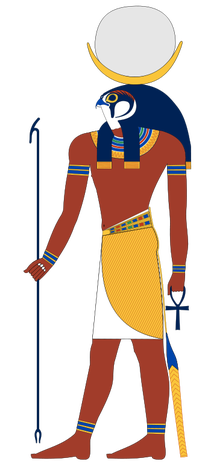Per-Khonsu
𓐍𓈖𓇓𓅱𓀭 𓐍𓈖𓊃𓇓𓅴 𓐍𓈖𓇓 𓐍𓈖𓇓𓅱
𓐍𓈖𓇓𓅱𓅆 𓐍𓈖𓊃𓇓𓅱 𓐍𓈖𓊃𓅱Pyramid texts
𓐍𓈖𓇓𓅱𓅮𓁹Theben 𓐍𓈖𓊃𓅱𓅆
MDC: xnsw
Alt Egyptian: ḫnsw, xnzw, ḫansu , ḫansaw
Gardiner: Khons
Budge: Khensu
Transliteration: Khensw
Adolf Erman and Hermann Grapow: Chons
Meroitic: Aqedise (pronounced akwəɖiɕ), Ḫs/Xs/𐦭𐦯, Ḫansa/Xansa (pronounced xansa)
Meroitic: ḫs /ḫansa/ḫasa 𐦭𐦯
Akkadian: ḫa-an-ša / 𒄩𒀭𒊭
Hebrew: Khonsu/ ח'ונסו, H'onso/ ח'וֹנסוּ
Coptic Sahidic: Shons/ϣⲟⲛⲥ, Khons < pakhons, Shōns < pašōns, Khans < pakhans,
Shoos < apšoos
Coptic Bohairic: Shons /ϣⲟⲛⲥ, Shōns < pašōns, Khōn(s) < pakhōn(s)(month)
Coptic Fayyumic: Shans, Shas
Coptic Thebian : Ⳉⲁⲛⲥ/Çans
Central Coptic : ʃɔns
Nahlic Coptic : ʃɑ̃ns
Ancient Greek : Χεσπισίχις/Khespisíkhis
Greek: Khōns /Χόνς , Khōn/χών < Παχών, khōn(s) < Pakhōn, Pakhōns, Pachons (month)
Demotic:
Arabic: Khonsu/خونسو , Shans < Bašans, بشن/Shns < ⲡⲁϣⲟⲛⲥ
English: Khonsu
Kemetic: Khonsu (Chons)
Alt: Chonsu, Khensu, Khons, Chons, Khonshu
IPA: (Old Egyptian, 2500 BCE) ˈχansVw ,
(Middle Egyptian, 1700 BCE) ˈχansVw ,
(New Egyptian) ˈχansə
(Medio-Late Egyptian,1350 BCE)ˈχansəʔ,
(Late Egyptian, 800 BCE) χans (Loprieno)
Pronounced: Khōns(ü) > Khōn Later
Alt Pronunciation: Khansaw, Khansu; Xanzaw (ref needed)
Meaning: "He who travels" - /xns/𓐍𓈖𓊃𓂻 "to travel" + /sw/𓇓𓅱"he"
Home: Night sky, TAr(w)
Temple: Waset/Thebes/Θῆβαι; nbwt (gold)/Ombos; Ipet-isut /Karnak
Cults: Min-nefer/Memphis/ Μέμφις, Hebet/Hibis, Beḥdet/Edfu/ إدفو
Nome:
Consort
Children
Father
Amun
Mother
Mut
Alternate parents
Bastet
Siblings
placenta (Associated with being the King's Placenta)
Alternative Parentage
Amun and Bastet
Priest names
Features
Younger man wrapped in mummy wrappings with green skin, a kings beard and a menat necklace. Or a hawk/falcon. In his hand he holds the Crook and flail or the Was scepter. Atop his head side-lock of hair he wears the scribes cap and a headdress with the crescent moon beneath the full moon. Sometimes he has a falcon's head. Sometimes he appeared as a goose, ram or two crocodiles.
Symbols
Number 9
Moon
Snakes
Baboon
Falcon
Lotus/ sSm
Roles
God of the new moon. New kingdom he was known as an exorcist and a healer. Protects against wild animals. In Karnak he was considered the great snake who fertilizes the cosmic egg. He was thought to watch overnight travelers. He was also invoked to protect against wild animals and aid in healing. Along with Djehuty/Thoth he marked the passage of time. Khonsu was instrumental in the creation of new life in all living creatures. In Thebes he was part of the triad of Mut and Amun.
Connection to other gods
Horu
Shu
Montju/ Montu (replaces the war god as son of Mut)
Celebrations
Offering items
Moon stone
Moon items
Gane boards, Senet
Other names
Epitaphs
aA-pHty / great of strength
aA-wr / very great
anx Hr ibw ? / (The one who) lives on hearts
nTr aA m nTrw aA ?/ Great god of the great gods
swAD / renew, make green
wHm-rnp / repeats rejuvenation
xnsw pA iry sxrw m wAst /Khonsu of Thebes The "Maker" of men's destinies or affairs
xnsw pA ỉri sxr.w/ Khonsu the Counsellor
ref.https://en.wikipedia.org/wiki/Khonsu, The Meroitic Language and Writing System By Claude Rilly, Alex de Voogt
Temple: Waset/Thebes/Θῆβαι; nbwt (gold)/Ombos; Ipet-isut /Karnak
Cults: Min-nefer/Memphis/ Μέμφις, Hebet/Hibis, Beḥdet/Edfu/ إدفو
Nome:
Consort
Children
Father
Amun
Mother
Mut
Alternate parents
Bastet
Siblings
placenta (Associated with being the King's Placenta)
Alternative Parentage
Amun and Bastet
Priest names
Features
Younger man wrapped in mummy wrappings with green skin, a kings beard and a menat necklace. Or a hawk/falcon. In his hand he holds the Crook and flail or the Was scepter. Atop his head side-lock of hair he wears the scribes cap and a headdress with the crescent moon beneath the full moon. Sometimes he has a falcon's head. Sometimes he appeared as a goose, ram or two crocodiles.
Symbols
Number 9
Moon
Snakes
Baboon
Falcon
Lotus/ sSm
Roles
God of the new moon. New kingdom he was known as an exorcist and a healer. Protects against wild animals. In Karnak he was considered the great snake who fertilizes the cosmic egg. He was thought to watch overnight travelers. He was also invoked to protect against wild animals and aid in healing. Along with Djehuty/Thoth he marked the passage of time. Khonsu was instrumental in the creation of new life in all living creatures. In Thebes he was part of the triad of Mut and Amun.
Connection to other gods
Horu
Shu
Montju/ Montu (replaces the war god as son of Mut)
Celebrations
Offering items
Moon stone
Moon items
Gane boards, Senet
Other names
Epitaphs
aA-pHty / great of strength
aA-wr / very great
anx Hr ibw ? / (The one who) lives on hearts
nTr aA m nTrw aA ?/ Great god of the great gods
swAD / renew, make green
wHm-rnp / repeats rejuvenation
xnsw pA iry sxrw m wAst /Khonsu of Thebes The "Maker" of men's destinies or affairs
xnsw pA ỉri sxr.w/ Khonsu the Counsellor
ref.https://en.wikipedia.org/wiki/Khonsu, The Meroitic Language and Writing System By Claude Rilly, Alex de Voogt
sw nDmwy Htp.k xnsw n nmH
it is sweet your grace, Khonsu, to the orphan
~Stela Turin 50052. (Catalogue No. 1553) Lower registers line 4



